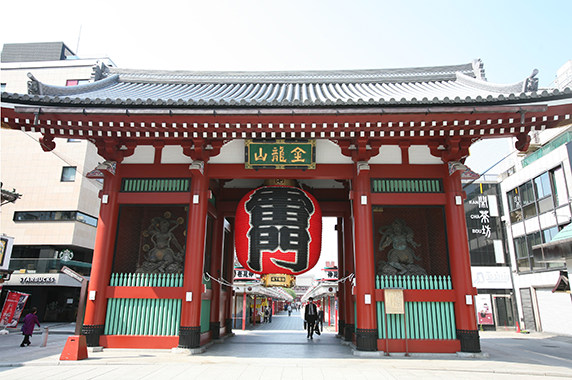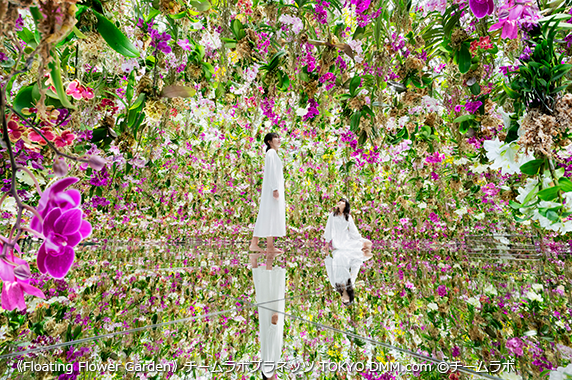*The times represent the approximate time needed to travel between major spots.
Day 1–3
Please the eye! A tour of Tokyo's art, old and new
Taking in the major art spots of Tokyo, encounter the artworks and structures by global artists of history and today.
Roppongi is a part of Tokyo where foreigners gather, and it is also a place where art galleries have risen up. Alight at Roppongi and you will see public art at every turn.
Enjoying strolling around the public artworks of Roppongi before moving to Ueno. From Ueno Station, the path to the art gallery is also lined with art.
At the National Museum of Western Art, perhaps Japan's most famous art museum, the building itself is listed as a UNESCO World Heritage site.
You should also take in Asakusa, one subway ride form Ueno. Commemorate your trip with a photo of Philippe Starck's eyecatching works or the symbol of Asakusa, Kaminarimon gate.
To cap your tour of Tokyo art, let's visit Toyosu, the latest art hotspot. Here, you can experience the new sensations of digital art from teamLab.
1
Roppongi Hills
Roppongi, a hub for galleries including the Suntory Museum of Art and the Mori Art Museum, is a key art hotspot in Tokyo. Arriving in Roppongi, you will find yourself face to face with artworks wherever you go. Here and there in the Roppongi Hills, you will find enormous public artworks by global artists and innovatively-designed street furniture. This forms the setting for an imaginative cultural heart of the city. Walking around streets full of color and sculpture is quite exhilirating.
 30 minutes by train(non-JR lines)
30 minutes by train(non-JR lines)
2
Ueno Park
(Asakura Fumio's Three Phases (intellect, emotion and will) and stained glass)
Ueno Park is an oasis in the city complete with galleries, museums, a zoo and wide open space. The first thing your eye is drawn to upon arriving at Ueno Station is the beautiful stained glass showing the Ueno town of old, just before you reach the gates of the Ginza subway line. Inside the building are works by sculptor Asakura Fumio. The National Museum of Western Art was designed by Le Corbusier, the giant of modernist architecture and is listed as a UNESCO World Heritage site. To walk the path to the art gallery itself is a chance to encounter numerous artworks.
 10 minutes by train(non-JR lines)
10 minutes by train(non-JR lines)
3
Asakusa
(Asahi Group Headquarters Building)
Now it's on to Asakusa, one of Japan's most famous tourist meccas. Leaving the station, one's eyes come to rest on an intriguing, large golden object perched atop a building (the Super Dry Hall) next to a unique beer-shaped building (Asahi Beer Tower) across the river. The golden object is actually an artwork by global French designer Philippe Starck, said to represent the burning heart of the company towards the new century. Asakusa is full of other attractions too such as Tokyo's oldest temple, Sensoji, the oldest amusement park, Hanayashiki, and Kappabashi Kitchenware Town.
 15 minutes by train(non-JR lines)
15 minutes by train(non-JR lines)
 15 minutes by bus
15 minutes by bus
4
teamLab Planets TOKYO
teamLab Planets TOKYO is a museum based on the concept of the "Body immersive." It is a novel digital art experience in which visitors attain unity with the art by immersing themselves physically in the giant art space. This is a place for adults and children alike to enjoy, and is also recommended as a date spot or family destination.
 30 minutes by train(non-JR lines)
30 minutes by train(non-JR lines)
 45 minutes by bus
45 minutes by bus
 30 minutes by high-speed boat
30 minutes by high-speed boat
Day 4–6
Visit art spaces on small islands and towns
After the thrill of the Toyosu digital art experience, we depart for the islands of the Seto Inland Sea, where the focus is contemporary art.
Immersed in nature amid sea and mountains, take in architecture built in harmony with the bucolic landscapes and numerous public artworks.
On the Seto Inland Sea islands of Naoshima and Inujima, even if you are visiting in a year when the Setouchi Triennale is not being held, there are still plenty of stunning regular exhibits.
The small mountain town of Kamiyama, Tokushima Prefecture, is famus for Kamiyama Artist in Residence, a long-stay program for artists to reside in the town. Artworks can be found in all parts of the community.
5
Naoshima's galleries and outdoor art
Naoshima is known as an island of contemporary art on the Seto Inland Sea. With its focus on artworks that harness the island's natural beauty and traditional culture, it attracts art enthusiasts from around the world. Kusama Yayoi's “Kabocha” (a fiberglass pumpkin) is a must-see (currently suffering typhoon damage, but awaiting repair). Art galleries designed by Ando Tadao, one of Japan's most renowned architects, dot the island. Why not visit them all for a sophisticated day out? Of particular note are the Benesse House Museum, a resort facility combining an art gallery with a hotel, the Lee Ufan Museum, and the Chichu (subterranean) Art Museum.
 55 minutes by high-speed boat
55 minutes by high-speed boat
6
Inujima
Inujima is a small island just 4km round which has become known for its art. Its icon is the Inujima Seirensho Art Museum, which has breathed new life into the ruins of an old copper refinery. This is an art museum with a unique perspective in its blend of ruins, architecture and artworks that gives rise to thoughts about the world today. Inujima hosts five small galleries and it is also a part of its Inujima "Art House Project" which displays works. Immerse yourself in a variety of artworks as you take in the wide natural panoramas of the island. (Not open in winter)
 85 minutes by higt-speed boat
85 minutes by higt-speed boat
 65 minutes by train(JR)
65 minutes by train(JR)
 55 minutes by bus
55 minutes by bus
7
Kamiyama Artist in Residence
Kamiyama is a small town nestled in the mountains. It has gained prominence as an art town thanks to the success of Artist in Residence, an initiative that started in 1999 inviting artists from around Japan and abroad to create and display their art. Mt. Oawa, in the middle of the town, is a place to enjoy the wide range of exciting works created so far by the artists. Soak up more art every autumn, when works are on display all around Kamiyama. Arts tours by staff can also be arranged in other seasons (fee payable/advance booking required). Please inquire to the KAIR office. After a hike, you can relax at Kamiyama Onsen, the hot spring at the foot of Mt. Oawa. Nearby is Kamiyama BEER, a craft brewery. They open a taproom on weekends so you can raise a glass in the middle of nature.
 55 minutes by bus
55 minutes by bus
 140 minutes by train(JR)
140 minutes by train(JR)
Day 7–10
Traditional performing arts and gardens: lose yourself in Japanese beauty
Once you have fully tasted the modern art of Shikoku, cross the bridge back to Honshu. It is time to immerse in the ancient arts of Japan.
First up, visit the Kurashiki Bikan Historical Quarter, where preserved streetscapes make the whole town a work of art. The Ohara Museum of Art is found here and displays a lot of modern and contemporary art from Japan and the West.
At the Adachi Museum of Art in Shimane, enjoy modern Japanese painting, ceramics and calligraphy, as well as a beautiful Japanese garden.
Your eyes opened to the wonders of Japanese art, the last stop is the Kashiwabara Art Museum in Yamaguchi, for its displays of weapons and art, including feudal armor, swords and tea utensils.
This finishes off a journey that fully satiates your appetite for Japanese and Western art of the past and present.
8
Ohara Museum of Art
The Kurashiki Bikan Historical Quarter is an area where narrow streets are lined by white-walled storehouses and tradesmen's houses. The Ohara Museum of Art is a symbol of the district and displays a strong lineup of modern and contemporary artworks from famous artists. The Main Gallery shows works by world masters, while the Annex Gallery has paintings and sculptures from leading Japanese artists modern and contemporary. The Handicraft/Eastern Gallery consists of rice granaries converted into exhibition spaces which richly reward a visit. With a superbly-stocked museum shop and a vibrant events calendar, this art museum is not just historical but very ambitious in the present.
 200 minutes by train(JR)
200 minutes by train(JR)
 20 minutes by bus
20 minutes by bus
9
Japanese gardens, Adachi Museum of Art
The Japanese gardens at the Adachi Museum of Art are a must-see. The meticulously maintained gardens cover a huge 165,000 square meters that change appearance with the seasons. They are indeed "living paintings." Together with its incredible collection of art, the museum as a whole has become world-renowned. On display are countless works from leading modern Japanese artists like the painter Yokoyama Taikan, ceramicist Kitaoji Rosanjin and others alike.
 20 minutes by bus
20 minutes by bus
 135 minutes by train(JR)
135 minutes by train(JR)
 JR Tokaido-Sanyo Shinkansen
JR Tokaido-Sanyo Shinkansen
 15 minutes by bus
15 minutes by bus
10
Kashiwabara Art Museum
Kintai Bridge
The Kashiwabara Art Museum is an extremely rare example in Japan of an art museum that exhibits weaponry. It not only covers samurai gear such as armor and swords from the Warring States to the Bakumatsu period, but also displays artistic items such as teawares that adds color into samurai households, giving you a close encounter with the culture in those days. The art museum is located in Iwakuni, which prospered as a castle town and has retained its Edo period character. The Kintai Bridge next to the art museum is also worth a look with its five beautiful arches - one of the world's only examples of such a bridge.
Here, we have presented a tour of various indoor and outdoor art forms, from art museums to public art and digital art, in Tokyo, Chugoku and Shikoku.
Means of transportation are provided for your reference, but it is always a good idea to take a stroll at your leisure around the locations mentioned.
*The information provided here is as of March 2022.
*Transportation information does not include the number of transfers or transfer time.
*Admission fees may be charged depending on the spot/facility. For the latest information on business hours, days when spots/facilities are reguarly closed, and prices, etc., please check the official website for each spot/facility or check directly with the spot/facility.


 30 minutes by train(non-JR lines)
30 minutes by train(non-JR lines)

 10 minutes by train(non-JR lines)
10 minutes by train(non-JR lines)

 15 minutes by train(non-JR lines)
15 minutes by train(non-JR lines)
 15 minutes by bus
15 minutes by bus

 30 minutes by train(non-JR lines)
30 minutes by train(non-JR lines)
 ANA Show details
ANA Show details
 45 minutes by bus
45 minutes by bus
 30 minutes by high-speed boat
30 minutes by high-speed boat

 55 minutes by high-speed boat
55 minutes by high-speed boat

 85 minutes by higt-speed boat
85 minutes by higt-speed boat
 65 minutes by train(JR)
65 minutes by train(JR)
 55 minutes by bus
55 minutes by bus

 55 minutes by bus
55 minutes by bus
 140 minutes by train(JR)
140 minutes by train(JR)

 200 minutes by train(JR)
200 minutes by train(JR)
 20 minutes by bus
20 minutes by bus

 20 minutes by bus
20 minutes by bus
 135 minutes by train(JR)
135 minutes by train(JR)
 JR Tokaido-Sanyo Shinkansen
JR Tokaido-Sanyo Shinkansen
 15 minutes by bus
15 minutes by bus
